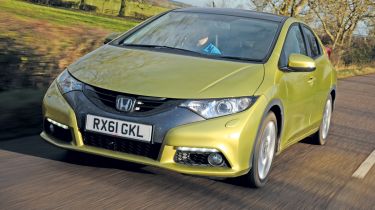Honda Civic
It’s evolution, not revolution, for Brit-built hatchback
Let’s be honest, the new Honda Civic looks like the old one. The bold shape that shocked us on the car’s launch in 2006 is still there, but if you study it closely there are lots of small giveaways to the fact that the body is completely new.
For starters, the new Civic is 20mm lower and 10mm wider than before. This gives it a sportier stance, while the visor-style front end has been replaced by larger lights and a piano black front facia. But the biggest changes have been made at the back.
In response to customer criticism of the old car’s poor rear visibility, the split in the two-piece back window has been lowered. The top part is now heated and has a wiper, plus the C-pillar has moved back 100mm to let more light into the cabin.
Despite all this effort, from behind the wheel the improvement in visibility is marginal. Even worse, the two-tier dash design means the top of the steering wheel can still obscure the high-level digital speedo – an inexcusable fault that should have been addressed. The steeply raked A-pillars also cause big blind spots and both rivals have a wider range of wheel and seat adjustment.
Used - available now

2022 Fiat
500
22,532 milesManualPetrol1.0L
Cash £9,549
2023 Honda
Jazz
24,192 milesAutomaticPetrol1.5L
Cash £14,999
2022 Vauxhall
Corsa
30,379 milesManualPetrol1.2L
Cash £11,549
2022 MINI
5-Door Hatch
32,498 milesAutomaticPetrol1.5L
Cash £15,049Honda has been more successful with the improvements it has made to plastic quality inside. But the new Civic still lacks the Volkswagen’s upmarket feel, as well as its simplicity; the dashboard is a bit busy. It’s better news in the back, as the deep 477-litre boot is the biggest in the test. Admittedly it does without a spare wheel, but the huge load area makes the Civic a versatile choice.
And that’s before you even try Honda’s ingenious Magic Seats. Pull a lever and the seats fold flat to offer a healthy 1,378-litre space – nearly as much as in an estate. The really clever bit is the cinema-style upward folding rear seat squabs, which make it easy to carry tall items upright on the floor.
The flat floor is also a plus for passengers in the middle rear seat, who benefit from decent legroom. The trouble is, the tapered roof restricts headroom across the back seat. Road noise is better isolated from the cabin than before, but Honda claims the biggest improvements have been made to the driving experience, and to the ride comfort in particular. Here, at least, the company has been successful.
It’s instantly obvious that the rigid set-up of the old car has been banished and there’s now far more give in the suspension. Nasty potholes still upset the Civic a fraction more than the other cars and the suspension doesn’t cope with expansion joints as well as the Ford or VW, but the newcomer rides well.
There is a price to pay, though, as the changes have blunted the old car’s sharp responses. Make no mistake, the Honda still handles well, but the chassis and its reactions feel a fraction softer. Grip remains strong but there is less front-end bite than in the Focus and Golf.
The steering has also lost some of its precision and, compared to the Focus in particular, there’s less feedback, leaving you with little sense of what the front end is doing. Yet there’s no faulting the light but snappy gearshift action, and the Honda recorded the shortest stopping distances in our brake tests.
Under the bonnet, the 2.2-litre diesel gives the car a 10bhp power advantage over its rivals and it sprinted from 0-60mph in 8.6 seconds – that’s 1.2 seconds quicker than the VW and nine-tenths up on the Ford.
On paper the Honda has plenty of torque – it offers 20Nm more than the Golf and Focus, at 350Nm – but the narrow power band affects in-gear responses. The car feels slower to react on the road and wasn’t as quick at the test track, plus the i-DTEC gets a little rough outside its mid-range sweet spot.
On the plus side, it’s 29g/km cleaner than the old engine – helped by standard stop-start – and there’s even an Eco button that softens throttle responses and reduces the drain of the air-con to improve economy further. The Civic is the cleanest car in this test in terms of CO2 emissions, but we averaged 37.7mpg in our tests – the worst here.
Strong residuals and Honda Happiness fixed-price servicing are a plus for private buyers looking at running costs. The latter covers five years or 62,500 miles of checks for an up-front fee of £895. High-spec cars come with plenty of equipment, too.
So Honda has addressed some, but not all, of our criticisms of the old car. The question is whether it’s done enough to beat the best.
Details
Chart position: 3
WHY: UK-built Civic is distinctive inside and out. Although the car in our pictures is an EX GT version, we test an ES model.







